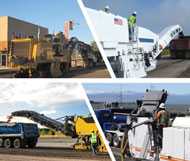NIOSH and Partners Recommend Controls for Silica Exposure during Asphalt Pavement Milling
March 12, 2015
NIOSH Update:
Press Contact: Nura Sadeghpour (202) 245-0673
The National Institute for Occupational Safety and Health (NIOSH) has developed a new document through the Silica/Asphalt Milling Machine Partnership that provides best practices to help reduce respirable silica exposures during asphalt pavement milling in highway construction. Highlights from the document will be presented on March 17th in Baltimore, Maryland by Dr. Christine Branche, Director of NIOSH’s Office of Construction Safety and Health, at the World of Asphalt Show & Conference 2015, the leading exposition and education resource for the asphalt industry.
Approximately 367,000 U.S. workers are employed in highway, street, and bridge construction and are at risk of exposure to respirable crystalline silica.[i] Workers use a variety of machinery when removing and recycling asphalt pavement; a number of them use cold-milling machines with toothed, rotating cutters that grind and remove the pavement, or work in close proximity to them. Dust generated from the cold-milling machines often contains respirable crystalline silica which can be transported by currents to the air workers breathe. The NIOSH document of best practices, which represents more than ten years of collaborative research between partners working under the Silica/Asphalt Milling Machine Partnership, provides recommendations that include ventilation controls in addition to water sprays used to cool the cutting teeth of milling machines, lessening silica dust exposure.
“Inhalation of respirable crystalline silica can cause silicosis, a debilitating and potentially fatal lung disease, and other possible adverse health outcomes,“ said NIOSH Director John Howard, M.D. “This collaborative effort by labor, industry and government reflects the current knowledge of best practices and a partnership that has succeeded in developing recommended engineering controls for these worksites.”
In their studies, NIOSH and partners collected 42 worker personal breathing zone air samples at 11 different highway construction sites. They found that machines that adopt this well-designed dust control approach reduced worker exposures to respirable crystalline silica from asphalt milling operations.
NIOSH and the Silica/Asphalt Milling Machine Partnership include the following as recommendations to reduce worker exposure to respirable crystalline silica:
- Placement of ventilation controls on all new asphalt milling machines
- Maximizing cover around the cutter drum and conveyor belts of milling machines
- Designing an outlet that releases dust at high speed away from the worker, if the ventilation control on the machine does not already include a dust collector
- Water sprays that are used to prevent or suppress dust on milling machines if ventilation dust controls are not available
The document additionally provides machine manufacturers guidance for evaluating current and future dust controls. To access the best practices document, please visit: http://www.cdc.gov/niosh/docs/2015-105. To learn more about engineering controls for silica in construction please visit: http://www.cdc.gov/niosh/topics/silica/constructionControlMain.html
NIOSH is the federal agency that conducts research and makes recommendations for preventing work-related injuries, illnesses, and deaths. For more information about NIOSH visit http://www.cdc.gov/niosh/.
 Tweet this: #Want to know more best practices for reducing silica exposure among asphalt pavement millers? Check out this @NIOSH study: http://go.usa.gov/3cseQ
Tweet this: #Want to know more best practices for reducing silica exposure among asphalt pavement millers? Check out this @NIOSH study: http://go.usa.gov/3cseQ
 Post this: Read up on NIOSH & partners best practices to help reduce respirable silica exposures during asphalt pavement milling in highway construction: http://go.usa.gov/3cseQ
Post this: Read up on NIOSH & partners best practices to help reduce respirable silica exposures during asphalt pavement milling in highway construction: http://go.usa.gov/3cseQ
[i] U.S. Census Bureau [2007]. Industry statistics sampler. NAICS 237310. Highway, street, and bridge construction. Washington, DC: U.S. Department of Commerce.
- Page last reviewed: March 12, 2015
- Page last updated: March 12, 2015
- Content source:
- National Institute for Occupational Safety and Health Education and Information Division


 ShareCompartir
ShareCompartir
